How to Substitute Whole Wheat for White Flour
A quick and easy guideCo-authored by Lisa Britten wikiHow
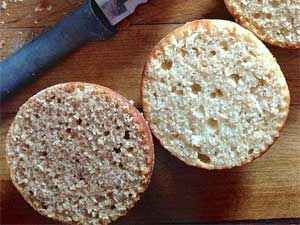
Substitute Whole Wheat for White Flour
Lots of people are making the switch from white flour to whole wheat flour, as it's a healthy alternative. It's best to start substituting whole wheat flour for white flour slowly to get used to the taste and texture, adding more and more later on. You can combat whole wheat flour's taste by balancing it out with other liquids such as orange juice, or sifting the flour to add more air to the texture.
Method 1 Adjusting Quantities

Adjust Quantities
1. Use ¾ cup of whole wheat flour to completely replace 1 cup of white flour. Whole wheat flour is denser and heavier than regular white flour. In order to produce baked goods with a similar texture to white flour, you'll want to use less whole wheat flour.
- Foods like cookies, scones, muffins, chocolate cakes, and quick breads taste good when made with whole wheat flour instead of white flour.
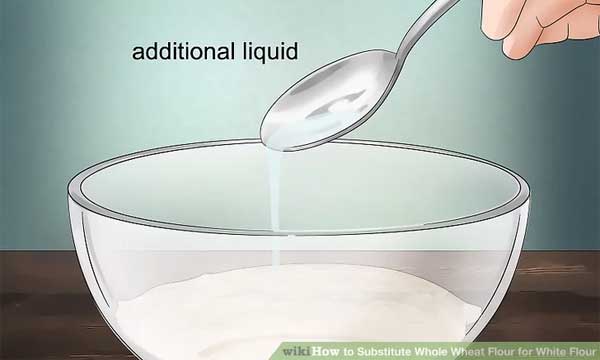
Add Additional Liquid
2. Add a little extra liquid when baking with whole wheat flour. Whole wheat flour absorbs liquid more slowly than white flour. Therefore, you will need to add additional liquid, such as water, to the mixture to prevent the finished product from being too dry.
- You can also use regular milk or buttermilk for additional liquid.
- For example, add 2 teaspoons (9.9 ml) of liquid per 1 cup (240 ml) of whole wheat flour.
- As whole wheat flour absorbs liquid more slowly, whole wheat doughs will be stickier than white flour doughs.
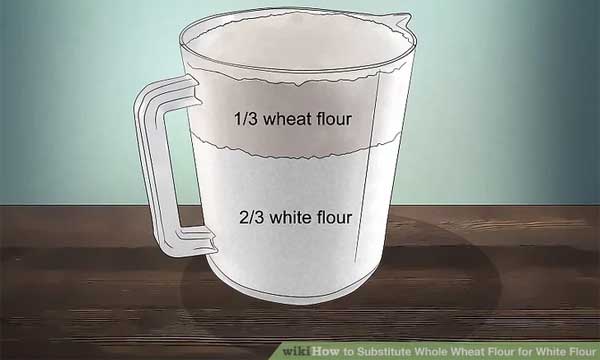
Substituting ⅓ to ½ the white flour
3. Try replacing only ⅓ to ½ the white flour at first. If you are new to using whole wheat flour, it's a good idea to start out by replacing just 1/3 or 1/4 of the white flour with whole wheat. This will give your taste buds time to adjust to the new flavor and texture.
- As you become accustomed to the whole wheat flavor, you can try substituting more and more of the white flour with the whole wheat, just as long as you're not making bread.
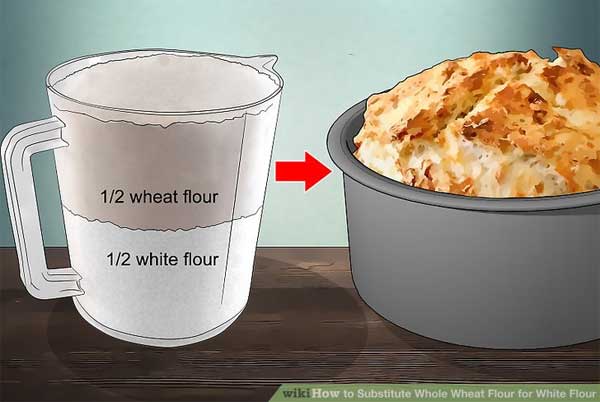
Replace up to ½ of the white flour
4. Replace up to 1/2 of the white flour if you're baking bread. Bread needs to rise in order for it to come out well and taste good. To ensure that your bread rises and bakes as it should, you shouldn't replace more than 1/2 of the amount of white flour needed.
- For example, if your recipe calls for 2 c (470 ml) of white flour, use 1 c (240 ml) of white flour and 1 c (240 ml) of whole wheat flour.
Method 2 Adding Additional Ingredients

Replace 2-3 tablespoons of liquid with orange juice
1. Add 2-3 tablespoons of orange juice to combat the bitter flavor of whole wheat flour. Whole wheat flour has a much stronger flavor than regular flour, and it can sometimes impart a bitter flavor to baked goods. To combat this, try replacing 2–3 US tbsp (30–44 ml) of the liquid used in the recipe, such as water or milk, with orange juice.
- The orange juice is sweet and full of natural sugars, so it will compensate for the bitter flavor of the whole wheat.
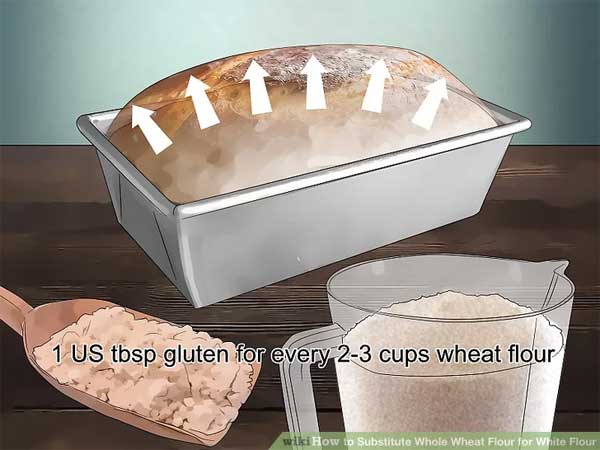
Add 1 tablespoon gluten for every 2-3 cups wheat flour.
2. Use wheat gluten to help whole wheat breads rise.
Whole wheat flour doesn't allow breads to rise as normal flour does, which is why you need to add wheat gluten. For every 2-3 cups (473-710 g) of whole wheat flour, add 1 US tbsp (15 ml) of vital wheat gluten.
- Wheat gluten can be found in the natural food section of your grocery store.

Try using white whole wheat flour.
3. Try using white whole wheat flour for a lighter texture and flavor. For softer baked goods like cakes and muffins, regular whole wheat can produce a harder, chewier result. To overcome this, try using white whole wheat flour instead.
- White whole wheat flour is made from a softer, lighter-colored type of wheat, whose taste isn't as strong as regular whole wheat.
Method 3 Getting the Most out of Whole Wheat Flour
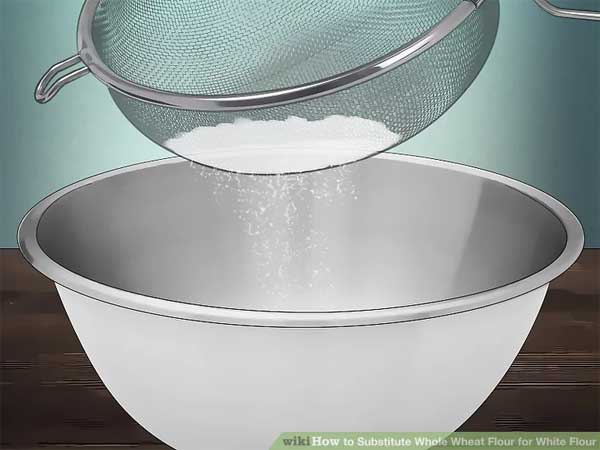
Getting the Most out of Whole Wheat Flour
1.Sift the whole wheat flour a couple of times to introduce more air. You can use a real sifter, or you can simply use a spoon to slowly sprinkle the whole wheat flour into the bowl of ingredients. This will add more air into the flour, making it a bit less dense.
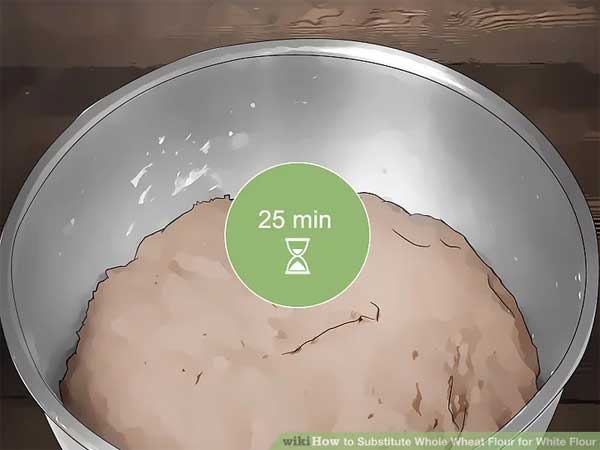
Rest the dough for 25 minutes.
2. Let the dough rest for 25 minutes before kneading it if using whole wheat flour. If you're making something like bread where the dough needs to be kneaded and/or rise, let it sit for about half an hour before starting the rest of the process to help the whole wheat flour work its best.
- Dough that contains whole wheat flour may also take longer to rise.
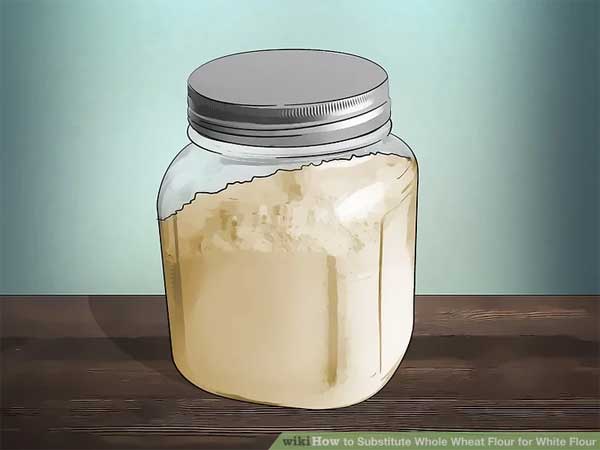
Store in sealed container.
Store whole wheat flour in a sealed container to keep it fresh.
After the flour is sealed, you can set it in the pantry for short-time use, such as 1-3 months. If you store the whole wheat flour in the freezer, you can keep it for up to 6 months before it starts to go bad.
- A resealable plastic bag works well, as does a plastic container.
This page was updated on March 17, 2024.
© TylerSpace.net 2000-2025.
Webmaster: Pat Tyler